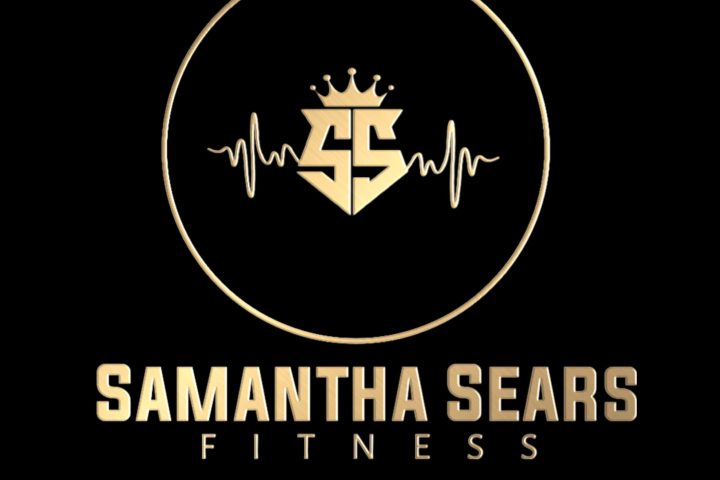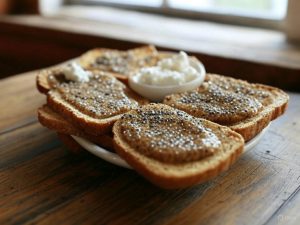High-Protein Post-Workout Snack Recipe: Cottage Cheese & Almond Butter Toast with Chia Seeds
Ingredients (Serves 1):
- 1 slice of whole-grain bread (preferably sprouted or sourdough for added nutrients)
- 1/2 cup low-fat cottage cheese (about 14g protein)
- 1 tablespoon natural almond butter (unsalted, no added sugar)
- 1 teaspoon chia seeds
- Optional: a drizzle of honey or a sprinkle of cinnamon for flavor
Nutritional Breakdown (Approximate):
- Calories: 300-350 kcal
- Protein: 18-20g
- Carbohydrates: 25-30g
- Fats: 12-15g
- Fiber: 5-7g
Preparation Instructions:
- Toast the slice of whole-grain bread until golden and crisp.
- Spread the almond butter evenly across the warm toast.
- Spoon the cottage cheese on top, distributing it evenly.
- Sprinkle chia seeds over the cottage cheese.
- Optional: Add a light drizzle of honey or a dash of cinnamon for extra flavor.
- Enjoy immediately!
Why It Works: This snack combines high-quality protein from cottage cheese, healthy fats from almond butter, and complex carbs from whole-grain bread, with a fiber and omega-3 boost from chia seeds. It’s portable, requires minimal prep, and delivers the nutrients your body craves after a workout.
The Importance of Refueling Your Body After a Workout: A Comprehensive Guide
Exercise is a cornerstone of a healthy lifestyle, whether you’re lifting weights, running, practicing yoga, or engaging in high-intensity interval training (HIIT). But what you do after your workout is just as critical as the effort you put in during it. Refueling your body with the right nutrients post-exercise isn’t just about satisfying hunger—it’s about optimizing recovery, supporting muscle growth, replenishing energy stores, and setting yourself up for long-term success. In this article, we’ll dive into the science of post-workout nutrition, explore why it matters, and explain how a simple yet powerful snack like Cottage Cheese & Almond Butter Toast with Chia Seeds can be your go-to recovery fuel.
Why Refueling After a Workout Matters
When you exercise, your body undergoes a series of physiological changes. Muscles contract, glycogen (stored energy in your muscles and liver) is depleted, and tiny tears form in muscle fibers (especially during resistance training). Sweat leads to fluid and electrolyte loss, and your metabolism kicks into high gear. These processes are all normal and, in fact, beneficial—they’re how your body adapts and grows stronger. However, they also leave your body in a state of stress and depletion. If you don’t refuel properly, you risk undermining your efforts, slowing recovery, and even increasing the likelihood of fatigue or injury.
Post-workout nutrition serves three primary purposes:
- Replenishing Glycogen Stores: Carbohydrates are your body’s primary fuel source during exercise. Intense workouts deplete glycogen, and without replenishment, your energy levels can crash, leaving you sluggish for hours—or even days.
- Repairing and Building Muscle: Protein provides the amino acids needed to repair muscle damage and stimulate muscle protein synthesis (MPS), the process by which your body builds new muscle tissue.
- Restoring Hydration and Balance: Alongside food, rehydration with water or electrolyte-rich fluids helps replace what’s lost through sweat and maintains proper cellular function.
Timing is also key. Research highlights the “anabolic window”—a period of about 30-60 minutes after exercise when your body is primed to absorb nutrients most effectively. While this window isn’t as rigid as once thought (especially for casual exercisers), eating within a couple of hours post-workout still maximizes recovery benefits.
The Science of Muscle Recovery
To understand why refueling matters, let’s break down what happens during and after exercise at a cellular level.
- Muscle Breakdown and Glycogen Depletion:
- During a workout, your muscles use glycogen as fuel. The more intense the session (e.g., heavy lifting or sprinting), the faster glycogen depletes.
- Resistance training causes microtears in muscle fibers, triggering inflammation and a subsequent repair process.
- The Role of Protein:
- After exercise, your body ramps up muscle protein synthesis to repair these tears. However, without adequate amino acids (the building blocks of protein), this process stalls.
- Studies, like one from the Journal of the International Society of Sports Nutrition (2017), recommend 20-40g of protein post-workout to maximize MPS, depending on your body weight and workout intensity.
- Carbohydrates and Energy:
- Carbs replenish glycogen stores, which can drop by 20-40% during a single workout. A 2018 study in Sports Medicine found that combining carbs with protein accelerates glycogen restoration compared to carbs alone.
- This is especially crucial if you train frequently—without refilled glycogen, your next workout could suffer.
- Fats as a Supporting Player:
- While carbs and protein take center stage, healthy fats aid in reducing inflammation and providing sustained energy. They’re not the priority immediately post-workout but can enhance a balanced snack.
In short, neglecting post-workout nutrition leaves your muscles starved for repair materials, your energy tanks empty, and your body less prepared for future challenges.
Who Needs Post-Workout Refueling?
The importance of refueling varies based on your fitness goals and workout type:
- Strength Trainers: If you lift weights or do resistance training, protein is critical for muscle repair and hypertrophy (growth). Carbs also help restore energy for your next session.
- Endurance Athletes: Runners, cyclists, and swimmers burn massive amounts of glycogen, making carbs a top priority alongside moderate protein.
- Casual Exercisers: Even if you’re doing light yoga or a brisk walk, refueling supports overall energy and prevents excessive hunger later.
- Fasted Trainers: If you work out on an empty stomach, post-workout nutrition becomes even more urgent to halt muscle breakdown and restore balance.
Regardless of your level, eating after exercise helps regulate blood sugar, reduce cortisol (a stress hormone that spikes during workouts), and kickstart recovery.
The Perfect Post-Workout Snack: What to Look For
An ideal post-workout snack balances macronutrients to meet your body’s needs:
- Protein: Aim for 15-25g to jumpstart muscle repair. High-quality sources include dairy, eggs, lean meats, or plant-based options like tofu or pea protein.
- Carbohydrates: 20-40g of complex carbs (e.g., whole grains, fruits) replenish glycogen without spiking blood sugar excessively.
- Fats: A small amount (5-15g) of healthy fats from nuts, seeds, or avocado supports inflammation control and satiety.
- Hydration: Pair your snack with water or an electrolyte drink to replace fluids.
Convenience matters too—post-workout, you’re often tired, sweaty, and not in the mood to cook a gourmet meal. That’s where our Cottage Cheese & Almond Butter Toast with Chia Seeds shines.
Spotlight on the Snack: Why Cottage Cheese & Almond Butter Toast Works
Let’s break down why this snack is a post-workout powerhouse:
- Cottage Cheese (Protein Power):
- Cottage cheese is rich in casein, a slow-digesting protein that provides a steady stream of amino acids to muscles over several hours. A half-cup delivers 14g of protein—perfect for recovery.
- It’s also high in leucine, an essential amino acid that directly triggers muscle protein synthesis.
- Whole-Grain Bread (Carb Replenishment):
- The complex carbs in whole-grain bread restore glycogen stores efficiently. Unlike white bread, it offers fiber and micronutrients like B vitamins, which aid energy metabolism.
- Sprouted or sourdough varieties have a lower glycemic index, providing sustained energy without a sugar crash.
- Almond Butter (Healthy Fats):
- Almond butter adds 3-4g of protein and 7-9g of monounsaturated fats per tablespoon. These fats reduce post-exercise inflammation and keep you full.
- It’s also a source of vitamin E, an antioxidant that combats oxidative stress from intense workouts.
- Chia Seeds (Bonus Nutrients):
- One teaspoon of chia seeds brings fiber, omega-3 fatty acids, and a small protein boost. Omega-3s further support anti-inflammatory recovery, while fiber aids digestion.
- Flavor and Flexibility:
- A touch of honey or cinnamon makes it tasty without overloading sugar. You can tweak it—add berries for extra carbs or swap almond butter for peanut butter based on preference.
At 18-20g of protein and 25-30g of carbs, this snack hits the sweet spot for most exercisers, delivering recovery fuel in under 5 minutes.
Beyond Muscle: Holistic Benefits of Refueling
Refueling isn’t just about muscles—it impacts your entire body:
- Hormonal Balance: Exercise spikes cortisol, which can break down muscle if unchecked. Eating carbs and protein lowers cortisol and boosts insulin, a hormone that aids nutrient uptake.
- Immune Function: Intense workouts temporarily suppress immunity. Nutrients like zinc (in cottage cheese) and antioxidants (in almonds) help bolster defenses.
- Mental Clarity: Low glycogen affects brain function, leading to post-workout fog. Carbs restore mental sharpness.
- Injury Prevention: Proper recovery reduces muscle soreness and fatigue, keeping you in top form for your next session.
Common Mistakes to Avoid
While refueling is vital, it’s easy to overdo it or miss the mark:
- Skipping It Entirely: Waiting too long to eat delays recovery and may increase muscle breakdown.
- Overeating: Post-workout hunger can lead to calorie overload. Stick to a balanced snack, not a feast.
- Too Much Sugar: Sugary drinks or candy provide quick carbs but lack protein and staying power.
- Ignoring Hydration: Food alone isn’t enough—drink water to rehydrate fully.
Tailoring Refueling to Your Goals
Your post-workout needs shift based on your objectives:
- Muscle Gain: Bump up protein to 25-30g and pair with 40g of carbs.
- Fat Loss: Keep carbs moderate (15-20g) and focus on lean protein to stay satiated without excess calories.
- Endurance: Prioritize carbs (40-50g) with 10-15g of protein.
The beauty of the cottage cheese toast recipe is its adaptability—add more bread for endurance or extra cottage cheese for muscle gain.
Practical Tips for Post-Workout Success
- Plan Ahead: Keep ingredients like cottage cheese and almond butter on hand for quick assembly.
- Portability: Pre-toast the bread and pack the toppings separately if you’re on the go.
- Listen to Your Body: Adjust portion sizes based on hunger and workout intensity.
- Hydrate First: Sip water during and after exercise to prime your system for food.
Conclusion: Fuel Smart, Recover Strong
Refueling after a workout isn’t optional—it’s a non-negotiable step to maximize your hard work. Whether you’re chasing strength, endurance, or overall health, the right nutrients at the right time help your body repair, recharge, and thrive. The Cottage Cheese & Almond Butter Toast with Chia Seeds is more than a snack—it’s a recovery tool, blending science-backed nutrition with simplicity and taste. Next time you finish a sweat session, skip the vending machine and whip up this high-protein gem. Your muscles, energy, and future self will thank you.

